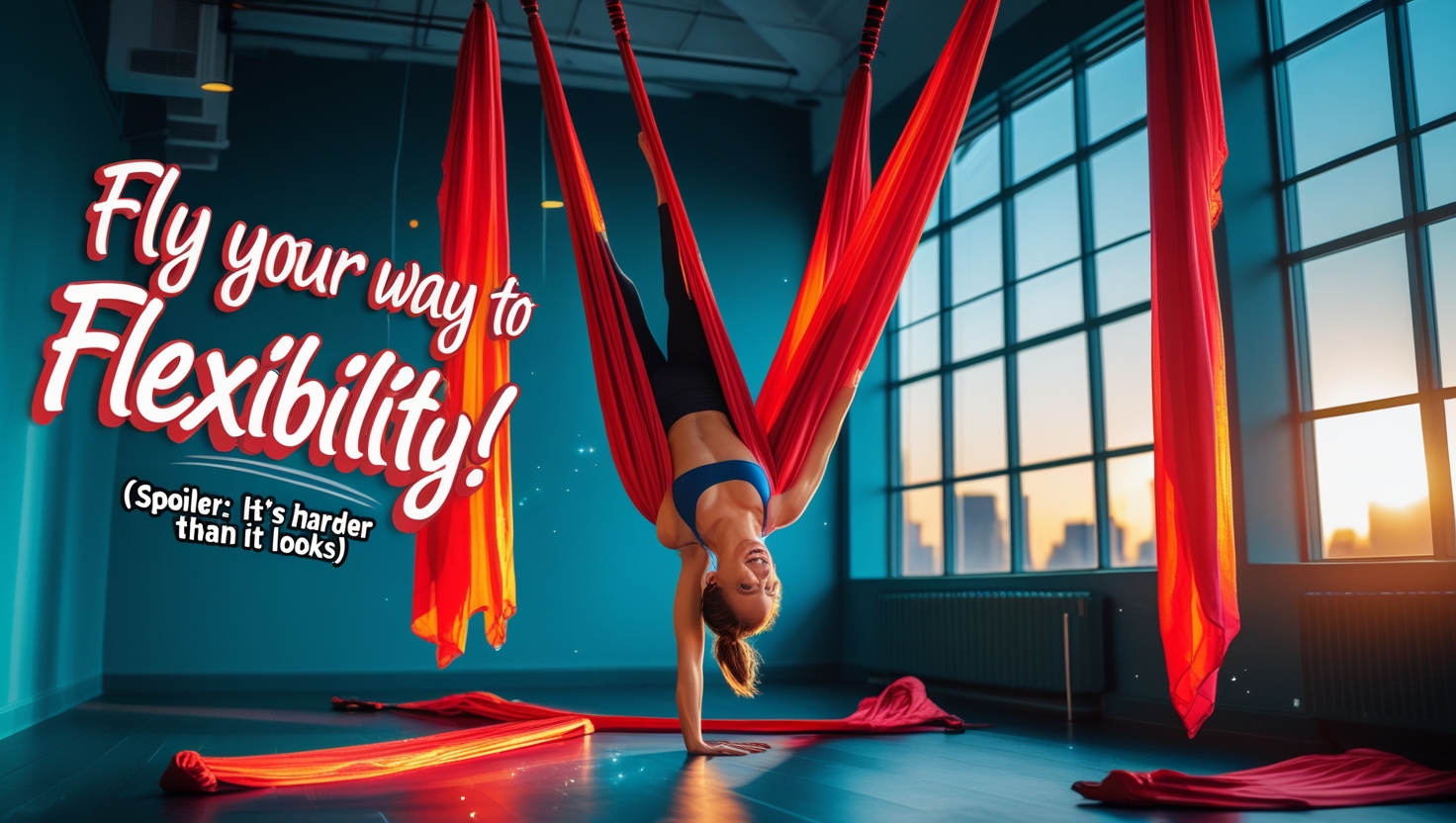Imagine defying gravity, stretching your body in ways you never thought possible, and feeling the exhilarating sensation of flying—all while achieving a deeper level of flexibility. Aerial yoga, a unique blend of traditional yoga and acrobatics using a suspended hammock, has been capturing the interest of fitness enthusiasts around the world. Although it may look fun and effortless in social media snapshots, the truth is that aerial yoga is a challenging practice that requires focus, strength, and dedication.
In this article, we explore everything you need to know about aerial yoga. We will dive into its origins, explain the benefits it offers, detail the challenges that make it “harder than it looks,” and provide practical tips for beginners. We also include real-life testimonials and answer frequently asked questions to help you decide if aerial yoga is right for you. Let’s take a deep dive into this innovative practice and discover how flying your way to flexibility can transform your body and mind.
What Is Aerial Yoga?
Aerial yoga is a modern form of yoga where practitioners use a special fabric hammock, also known as an aerial silks hammock or swing, suspended from the ceiling to perform poses. This hammock supports your body weight, allowing you to float and perform a variety of yoga postures and inversions safely.
The Unique Twist on Traditional Yoga
Unlike conventional yoga, where you work entirely on the floor, aerial yoga introduces a new element of suspension. The hammock offers support while challenging you to use your core, balance, and upper body strength. It can help deepen stretches and improve alignment by reducing the pressure on your spine and joints. The result is a practice that not only builds strength and flexibility but also enhances your balance and body awareness.
How It Works
During an aerial yoga class, you will typically begin on the floor with a brief warm-up. Once you are comfortable, you move into the hammock for various poses. The hammock is designed to cradle your body, offering support in challenging positions while also adding resistance. This allows you to gradually build muscle strength and flexibility in a safe environment. Although it may seem like you’re simply hanging, every movement in the hammock requires precise control and core engagement.
A Brief History of Aerial Yoga
Aerial yoga has its roots in both traditional yoga and aerial acrobatics. While yoga has been practiced for thousands of years to promote physical and mental well-being, aerial acrobatics have been part of circus arts and performance disciplines for decades. Aerial yoga emerged as a natural fusion of these practices, appealing to those who wanted to explore yoga from a new perspective.
The Evolution from AcroYoga to Aerial Yoga
In the early days, many practitioners experimented with elements of AcroYoga—a partner-based practice that combines yoga and acrobatics—to add a playful twist to their routines. Over time, innovative instructors developed classes that incorporated a suspended hammock, evolving the practice into what we now call aerial yoga. This evolution allowed individuals to experience the benefits of inversions and deep stretches without the fear of falling, as the hammock offers built-in support and stability.
The Rise in Popularity
Aerial yoga gained popularity through social media and word of mouth. Videos and images of graceful inversions and playful poses quickly spread online, attracting both seasoned yogis and beginners alike. Today, studios around the world offer aerial yoga classes, each adding its own style and flair to the practice. The promise of improved flexibility, core strength, and a fun, almost “flying” sensation has made aerial yoga a must-try for many fitness enthusiasts.
The Benefits of Aerial Yoga
Aerial yoga offers a wide range of benefits that make it an appealing practice for those looking to enhance both their physical and mental well-being. Here are some of the most noteworthy benefits:
Physical Benefits
- Improved Flexibility:
The hammock supports your body, allowing you to stretch deeper than you might on a regular yoga mat. Over time, this can lead to significant improvements in overall flexibility. - Enhanced Strength and Core Stability:
Every pose in aerial yoga requires engagement of your core muscles, along with your arms and legs, leading to improved overall strength. The challenge of maintaining balance in the hammock naturally builds core stability. - Spinal Decompression:
One of the most lauded benefits of aerial yoga is the ability to decompress the spine. By hanging upside down or letting your body be supported by the hammock, you can relieve pressure on the vertebrae and improve overall spinal health. - Better Balance and Coordination:
The suspended environment forces you to use your stabilizing muscles, improving balance and body coordination over time. This can translate into better performance in other physical activities. - Joint-Friendly Workouts:
Since the hammock takes on some of your body weight, there is less stress on your joints compared to traditional floor-based yoga. This makes aerial yoga a good option for those looking to protect or rehabilitate their joints.
Mental and Emotional Benefits
- Enhanced Mindfulness and Focus:
The unique challenges of aerial yoga require you to be fully present. As you concentrate on each movement, your mind is drawn away from daily stressors, enhancing mindfulness and overall mental clarity. - Stress Relief and Emotional Release:
The novelty and fun of flying through the air can trigger a sense of joy and freedom, reducing stress levels and encouraging emotional release. Many practitioners find that the practice leaves them feeling uplifted and more relaxed. - Boosted Self-Confidence:
Learning new and challenging poses can be a huge confidence booster. As you gradually master the moves, you build self-esteem and a greater sense of achievement. - A Sense of Playfulness:
Aerial yoga brings an element of fun to your fitness routine. The playful nature of the practice encourages you to explore movement without self-judgment, making it an enjoyable way to break out of your comfort zone.
Why It’s Harder Than It Looks
Even though aerial yoga appears graceful and effortless in photos and videos, the practice is actually quite challenging. Here’s why:
Building Strength Takes Time
When you first try aerial yoga, you may find that your muscles—especially your core and upper body—are not yet strong enough to support you in the hammock. The demands of holding your body weight, controlling your movements, and maintaining balance are much greater than they appear. Beginners often struggle with even simple poses until their muscles adapt to the new challenges.
The Learning Curve
Aerial yoga involves a significant learning curve. The coordination required to move smoothly in the air, the timing of transitions, and the trust needed to surrender your body to gravity all contribute to the difficulty. It takes time and practice to develop the necessary body awareness and technique, which is why many instructors stress the importance of patience and persistence.
Overcoming the Fear of Heights
For many people, the idea of being suspended in the air can be intimidating. Even though the hammock is designed for safety, the psychological challenge of letting go and embracing the feeling of flying can be a hurdle. Overcoming this fear is a critical part of the journey, and as you gradually build trust in the equipment and your instructor, the fear often diminishes.
The Demanding Nature of Inversions
Inversions—where you are upside down—are a key component of aerial yoga. While inversions are common in many yoga practices, doing them in the air adds an extra layer of difficulty. Your body must adjust to a completely different perspective, and maintaining proper alignment becomes more challenging. These poses require a strong core, precise control, and significant mental focus.
The Need for Constant Engagement
Unlike traditional yoga where you may have moments of rest between poses, aerial yoga often demands constant engagement of your muscles to maintain stability. This continuous effort can make a class feel more intense and exhausting, especially for beginners. It’s a full-body workout that tests both your strength and endurance.
What to Expect in an Aerial Yoga Class
If you’re considering trying aerial yoga, it helps to know what a typical class looks like. Here’s a breakdown of what you can expect:
1. Arrival and Setup
When you enter an aerial yoga studio, you’ll notice the open space with hammocks hanging from sturdy ceilings. Instructors usually provide a quick safety briefing, explaining how to use the hammock and demonstrating basic movements. Make sure to wear comfortable, form-fitting clothing that allows you to move freely. Avoid jewelry and loose items that might get caught in the fabric.
2. Warm-Up on the Floor
Most classes begin with a gentle warm-up on the floor. This helps prepare your muscles for the aerial work ahead. You might engage in light stretching, breathing exercises, or a brief meditation to center your mind.
3. Introduction to the Hammock
After the warm-up, the instructor will introduce you to the hammock. You will learn how to step into it safely, adjust your body position, and use the fabric to support different poses. This introduction is crucial for building confidence and ensuring you feel comfortable with the equipment.
4. Flowing Through Aerial Poses
Once you’re familiar with the hammock, the class moves into a series of poses. These can include both traditional yoga postures adapted for the air and unique aerial movements. Common poses include:
- Suspended Mountain Pose: Standing tall in the hammock to engage your core.
- Floating Warrior: A pose that challenges your balance while opening up the hips and chest.
- Inversion Poses: Inversions such as a supported headstand or shoulder stand that allow for spinal decompression and enhanced flexibility.
- Suspended Child’s Pose: A gentle, restorative pose that helps release tension in the back and shoulders.
Throughout the class, you will learn how to use the hammock for support while also challenging your muscles. The instructor will provide modifications for those who are new or need extra support.
5. Cool-Down and Relaxation
After the active portion of the class, you’ll move into a cool-down phase. This typically involves gentle stretches and relaxation poses to help your body recover. Many classes end with a few minutes of quiet relaxation or meditation, allowing you to absorb the benefits of your practice and reflect on your progress.
6. Post-Class Reflection
After the session, you might spend some time discussing your experience with the instructor and other participants. This reflection helps reinforce what you’ve learned, celebrate small victories, and set intentions for your next class.
Key Equipment and Safety Considerations
Because aerial yoga involves suspension and inversion, using the right equipment and adhering to safety protocols is essential.
The Hammock
The central piece of equipment is the fabric hammock. High-quality hammocks are made from durable, non-stretch fabric designed to safely support your weight. The fabric is attached to a robust rigging system that must be installed by professionals. Always ensure that your studio adheres to strict safety standards.
Clothing and Accessories
- Wear Form-Fitting Clothes: This minimizes the risk of fabric entanglement and allows instructors to see your alignment clearly.
- Avoid Jewelry: Remove earrings, necklaces, or any accessories that might interfere with the fabric.
- Yoga Mat (Optional): Some practitioners bring a yoga mat for floor work before and after using the hammock.
Safety Tips
- Listen to Your Instructor: Their guidance is critical for mastering the moves and avoiding injuries.
- Practice at Your Own Pace: Don’t push yourself too hard. Aerial yoga is challenging, and progress comes with time.
- Warm-Up Thoroughly: Ensure your body is prepared for the demands of suspension and inversion.
- Be Aware of Your Limits: If a pose feels unsafe or uncomfortable, ask for a modification or take a break.
- Stay Hydrated: A full-body workout like aerial yoga can be intense, so drink plenty of water before and after class.
How Aerial Yoga Differs From Traditional Yoga
While both traditional and aerial yoga share a focus on breath, balance, and mindfulness, there are several key differences:
Support vs. Challenge
- Traditional Yoga: Typically practiced on a stationary mat on the floor. It relies on your own strength and balance for poses.
- Aerial Yoga: Uses the hammock for support and to challenge your muscles in new ways. The suspension helps reduce joint pressure while simultaneously demanding greater core engagement.
Perspective and Space
- Traditional Yoga: Offers a grounded experience where you connect with the earth.
- Aerial Yoga: Creates a sensation of floating or flying, offering a fresh perspective that can shift your mindset and boost creativity.
Physical Demands
- Traditional Yoga: Builds flexibility and strength in a controlled manner.
- Aerial Yoga: Combines flexibility, strength, and coordination with the added challenge of working against gravity. This makes the practice more dynamic and can lead to faster gains in strength and balance—provided you give your body time to adapt.
Who Should Try Aerial Yoga?
Aerial yoga is not for everyone, but it offers something unique for many different types of practitioners:
Beginners and Intermediates
Even if you’ve never done yoga before, many studios offer beginner-friendly aerial yoga classes. Instructors provide step-by-step guidance, making it easier to get acquainted with the equipment and techniques.
Those Seeking a New Challenge
If you’re a regular at traditional yoga and looking to add a fun, challenging twist to your routine, aerial yoga might be the perfect choice. It offers a fresh way to test your limits and improve your flexibility and core strength.
Individuals with Joint Pain
Because the hammock supports your body, aerial yoga can be a joint-friendly alternative to floor-based workouts. Many people with back pain or joint issues find that the decompression effects of aerial yoga relieve tension and improve mobility.
Adventurous Spirits
If you enjoy trying new activities and stepping out of your comfort zone, aerial yoga’s combination of playfulness and physical challenge can be incredibly rewarding. The experience of “flying” and learning inversion poses is unlike any other workout.
Tips for Getting Started
Starting aerial yoga might feel intimidating, but these tips can help you ease into the practice:
- Choose a Reputable Studio: Look for studios with certified instructors and well-maintained equipment. Reading reviews and asking for recommendations can help you find the right fit.
- Wear the Right Attire: Opt for comfortable, close-fitting clothing that allows for free movement. Avoid items that could get caught in the hammock.
- Arrive Early: Give yourself time to familiarize yourself with the studio and the setup. This extra time can help reduce any initial anxiety about being suspended.
- Stay Hydrated: Drink water before and after class. Aerial yoga is physically demanding, and proper hydration is key.
- Keep an Open Mind: Remember that everyone progresses at their own pace. Focus on your personal journey rather than comparing yourself to others.
- Ask for Help: Don’t hesitate to ask your instructor for modifications or extra support when needed.
- Practice Regularly: Like any new skill, progress in aerial yoga comes with consistent practice. Start with shorter sessions and gradually increase your practice time as your strength and confidence grow.
Real-Life Experiences: Stories From the Air
Hearing from others who have taken the plunge into aerial yoga can be inspiring. Here are a few stories that capture the spirit of the practice:
Jessica’s Journey to Confidence
Jessica, a busy professional with little free time, decided to try aerial yoga on a whim. “At first, I was terrified of the idea of being suspended in the air,” she recalls. “But with the gentle guidance of my instructor and the supportive environment of the class, I gradually built up my strength and confidence. Now, aerial yoga has become a highlight of my week—I feel lighter, both physically and mentally.”
Michael’s Transformation
Michael had been practicing traditional yoga for years but was looking for something that pushed his boundaries further. He found aerial yoga to be both challenging and exhilarating. “Every class feels like a mini-adventure. The upside-down poses really help with my posture and have eased my chronic back pain. It’s hard work, but the results are worth every minute of it,” he says.
Emma’s Tale of Overcoming Fear
Emma was initially hesitant to join an aerial yoga class because of her fear of heights. However, she quickly learned that the structured support of the hammock and the patient encouragement from her instructor made all the difference. “I still get a little nervous every time I try an inversion, but each class helps me push past that fear. It’s taught me not only about my body but also about trusting myself,” she explains.
The Challenges and Rewards of Aerial Yoga
Aerial yoga is a full-body workout that offers both immediate challenges and long-term rewards. Here are some of the aspects that practitioners often encounter:
Physical Challenges
- Strength Building: The need to constantly engage your core, arms, and legs can be exhausting at first. Over time, however, you’ll notice a significant improvement in muscle tone and endurance.
- Balance and Coordination: The instability of the hammock forces you to develop a keen sense of balance, which can be both frustrating and incredibly rewarding as you progress.
- Flexibility Gains: Deep stretches supported by the hammock can feel intense initially. With practice, you can achieve greater flexibility without risking strain.
Mental and Emotional Rewards
- Overcoming Fears: Facing the challenge of being suspended in the air can boost your confidence and help you overcome fears—not just on the mat, but in other aspects of life.
- Increased Focus: The concentration required to perform aerial poses improves mental clarity and focus. This mindfulness can extend into your daily routine.
- Joy and Playfulness: The sense of “flying” and the novelty of each session add an element of fun that can brighten even the toughest days.
FAQs
Q1: What exactly is aerial yoga?
A: Aerial yoga is a form of yoga that uses a suspended fabric hammock to support and challenge your body in various yoga poses. It combines elements of traditional yoga and acrobatics, providing benefits like improved flexibility, core strength, and spinal decompression.
Q2: Do I need prior yoga experience to try aerial yoga?
A: No prior yoga experience is necessary. Many studios offer beginner-friendly classes with modifications and step-by-step instructions. It’s a great way to start your yoga journey in a supportive environment.
Q3: What should I wear to an aerial yoga class?
A: Wear comfortable, form-fitting clothing that won’t interfere with the hammock. Avoid loose fabrics and jewelry that could get caught in the fabric. Form-fitting clothes also help instructors see your alignment clearly.
Q4: Is aerial yoga safe for everyone?
A: While aerial yoga is designed to be safe and accessible, individuals with certain medical conditions, severe joint issues, or a fear of heights should consult a doctor before trying it. Always inform your instructor about any concerns or limitations.
Q5: What are the main benefits of aerial yoga?
A: Aerial yoga offers many benefits including improved flexibility, enhanced core strength, spinal decompression, better balance, and mental clarity. It also helps reduce stress and can boost confidence by challenging you in new ways.
Q6: How long is a typical aerial yoga class?
A: Most aerial yoga classes last between 60 and 90 minutes, including warm-up, active practice, and cool-down. The structure can vary slightly from studio to studio.
Q7: What kinds of poses can I expect in aerial yoga?
A: You will perform a mix of traditional yoga poses adapted for the hammock, such as suspended mountain pose, warrior poses, and inversions like headstands or shoulder stands, as well as unique aerial movements that challenge your balance and coordination.
Q8: I’m scared of heights. Can I still try aerial yoga?
A: Yes, many people with a fear of heights have successfully overcome their concerns through aerial yoga. The hammock is designed for safety and support, and instructors help you progress at your own pace until you feel comfortable.
Q9: How often should I practice aerial yoga to see improvements?
A: Like any exercise, consistency is key. Attending classes 2–3 times per week can help you see noticeable improvements in strength, flexibility, and overall well-being over time.
Q10: Can aerial yoga help with back pain?
A: Many practitioners find that the spinal decompression and gentle stretching offered by aerial yoga can relieve back pain. However, if you have severe or chronic back issues, consult your healthcare provider before beginning any new exercise regimen.
Conclusion
Aerial yoga is a captivating fusion of movement, strength, and creativity that elevates traditional yoga to new heights—literally. While it may seem like an effortless display of grace and balance, the practice is challenging and demands consistent effort, focus, and perseverance. Whether you’re looking to deepen your flexibility, strengthen your core, or simply add a touch of adventure to your fitness routine, aerial yoga offers a unique pathway to transforming both your body and mind.
The benefits of aerial yoga extend far beyond physical strength. As you learn to trust your body and overcome the fear of being suspended in the air, you also discover new reserves of mental clarity and emotional resilience. The playful, yet demanding nature of the practice makes each class an opportunity to grow, laugh, and fly—if only for a few moments.
For those ready to embrace a workout that challenges conventional limits and offers a fresh perspective on movement, aerial yoga might just be the transformative experience you’ve been searching for. Remember, every expert was once a beginner. With patience, practice, and the right guidance, you can master the art of flying your way to flexibility—no matter how hard it looks at first.
So, if you’re ready to challenge yourself, overcome your fears, and experience the liberating sensation of flying, give aerial yoga a try. Embrace the journey, celebrate small victories, and enjoy every moment of this unique practice that takes both body and spirit to new heights.
Happy flying, and namaste!













Add comment